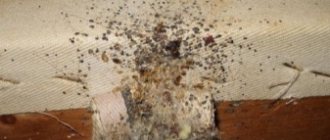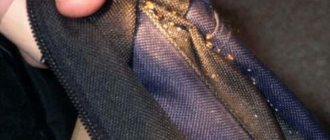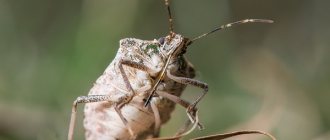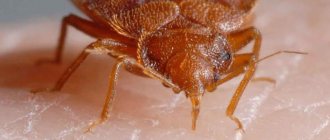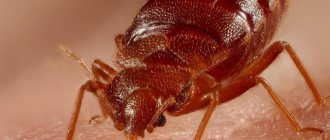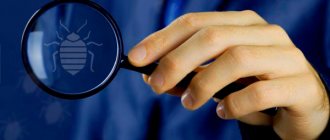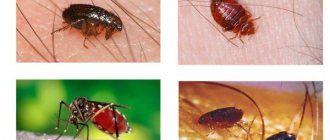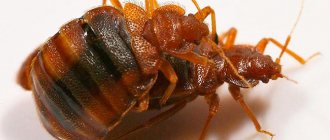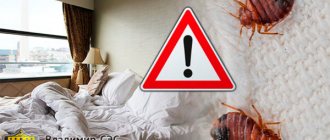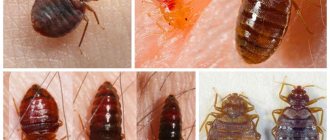Bedbugs are blood-sucking insects. During a bite, parasites can infect the victim with various infectious diseases. It is difficult to notice bloodsuckers, but knowing what traces bedbugs leave, you can easily determine their presence in the house.
Traces of blood may be visible on the bed after a bite; in addition, the parasites leave behind waste products and a specific odor. They reproduce quickly, so if detected early, it is easier to remove the pests.
Traces on the bed
On the bed, traces of bedbugs are visualized in the form of bloody spots formed after a parasite bite when blood oozes from the wound. Usually they are minor. But if you crush the bloodsucker, the stain can be large.
On the bed you can find chitinous membranes after molting nymphs and feces of parasites . These are clear signs of bedbugs in the apartment. If they are found, you should carefully inspect the apartment.
Important. During baiting, bloodsucker eggs do not die, since the protective layer protects the insect’s body. To completely get rid of pests, repeat disinfection is carried out after 1-2 weeks.
It is very difficult to remove bedbugs from your home, since adult bedbugs live for about a year, and during this time they can lay up to 500 eggs. Under unfavorable conditions, the parasite can go into suspended animation, which then extends its lifespan.
The most effective method of control is heat treatment of the room.
Preventing the appearance of fungus in the apartment
After effectively eliminating mold from wallpaper and preventing its reappearance, you should not forget about prevention. Simple preventive measures include:
- Regular ventilation of the living space. The flow of fresh air will prevent the proliferation of fungal spores. In winter, the apartment must also be ventilated, but the window must be opened for a short period to avoid condensation.
- The living space should be thoroughly insulated.
- Drying washed clothes in an apartment is not recommended.
- If possible, reduce the number of indoor plants.
- Repair all pipes.
- Install a high-quality ventilation system in the bathroom and toilet.
What other traces do they leave?
Any traces of bedbugs should alert the owners. If you do not get rid of parasites in a timely manner, then within a few months a whole colony of bloodsuckers will form.
Characteristic signs of presence include:
- Bites on the body in the form of a track.
- Sweetish smell in the apartment.
- Black dots on the bed, wallpaper, furniture.
- Chitin shells.
- Clutches with eggs.
- Bloody traces of bedbugs on the sheet.
To ensure the presence of parasites, you need to carefully inspect the mattresses and sleeping areas. Sometimes bloodsuckers hide in baseboards or old furniture; if you turn on the lights at night around 2-4 o'clock in the morning, you can see adult individuals going out hunting.
Insects have a flattened body, about 1 cm in length, antennae, and three pairs of legs. Nymphs are smaller in size and lighter in color.
When they are full, their body takes on a characteristic bloody color. Adult insects are dark in color regardless of food intake.
Detection methods
House bugs leave behind various waste products. They can be seen with the naked eye. There are parasites in your home if:
- there are blood stains on the bed in the morning;
- has trouble sleeping at night;
- you notice bites on the skin, they look like mosquito bites;
- There are black dots on furniture and wallpaper.
Black dots on the wallpaper are traces of bedbug waste products
If you have any of these signs at home, you should contact a pest control service. It is difficult to remove parasites on your own. It is worth remembering that an insect’s clutch can contain up to 60 eggs, which means that soon the room will be swarming with insects. Before calling service, you should make sure that there are actually insects and that you are not confusing the symptoms with mosquito bites.
Main traces of life
Traces of bedbug activity are found on bedding and next to the bed. They are dense to the touch and resemble black dots in appearance. This is parasite feces. When a bug becomes saturated, its digestion is activated and defecation occurs.
The excrement is initially liquid, but upon contact with air masses it hardens . The smell is reminiscent of low-quality cognac. The same excrement is found in nests where pests go to digest food and reproduce.
Specific smell
You can detect bed bugs in an apartment by the sweetish almond aroma in the room. It feels especially bright after the street. Bloodsuckers have special glands that are activated at the moment of danger.
They create a specific smell. Thanks to these glands, pests find their clan after moving a long distance. Bedbug feces also have a similar aroma.
Chitin shells
Chitinous shells also indicate the presence of parasites. The larva has an exoskeleton in the form of a shell. When the nymph is older, it gradually grows after each meal. This shell becomes too small for her, she throws it off.
The first skin is light and thin; the larger the insect, the darker and denser its chitinous shell . During the process of growth to adulthood, several stages of molting are observed. The skins help to distinguish bedbugs from other living creatures in the apartment that can harm people.
Since bloodsuckers love to settle in old things, the shell can be found in these places. If the room is heavily infested, skins can be found on the sofa, bed, and furniture.
Useful tips
Useful tips will also help you avoid the appearance of mold:
- The basement must be well insulated, and interpanel seams must be repaired if necessary.
- Give preference to hinged models of metal-plastic windows, which will provide effective ventilation.
- It is advisable to install an additional hood.
- If there is groundwater and melt water in the basement, the problem should be eliminated to prevent it from entering the apartment.
- Try to complete the repairs before the onset of autumn or start gluing wallpaper after turning on the central heating.
It is not easy to destroy mold on wallpaper on your own, but it is possible if you follow all the recommendations. If possible, you should seek help from professionals. When starting a renovation, before gluing the wallpaper, you need to treat the walls with an antiseptic solution in order to prevent the appearance of mold in the future.
Clutches of eggs
Adults, after receiving the next portion of blood, begin to reproduce. Their eggs resemble small translucent grains of rice.
Bed bugs nests are located close to the food source - near beds, sofas . Sometimes females protect their offspring from possible detection and hide eggs in old things, behind baseboards.
If masonry is discovered, it must be destroyed using boiling water or mechanically. If this is not done, new bloodsuckers will hatch from the eggs and continue their population.
On average, one egg takes 2 weeks to mature, so in a month entire armies of bloodsuckers will be traveling around the house.
Why does mold appear on wallpaper, what is it like and how to get rid of it?
The presence of mold on the walls is typical not only for old houses, but also for new buildings. The black spots that appear on the wallpaper do not decorate the apartment at all and cause significant harm to health. When the first black spots are detected, you should immediately begin to fight mold. This article describes in detail the causes of blackening, discusses the types of household mold, as well as methods for preventing and combating formations on wallpaper.
Traces on the human body
So what traces do bedbugs leave on the human body? According to doctors, after an insect bite, a red bump remains at the site of penetration. It is very itchy, swollen, and painful.
Therefore, a large red spot makes people think that mosquitoes have settled in the house. Residents begin to actively fight flying bloodsuckers, while bedbugs continue to increase their population.
In some people, bedbug bites cause an allergic reaction, then it is difficult to correctly differentiate a harmless wound . After insects, red spots resemble bumps, but not pimples.
The swellings are very painful, itchy, and inflamed. If you scratch the penetration site, there is a risk of infection, which complicates treatment.
When pests settle, the number of bites gradually increases, being located chaotically on the body in places accessible to penetration. The allergy covers areas of the skin completely, it is smaller and is localized not only in open areas of the body.
Bites
To understand that it is a bug that bites and not another insect, it is worth examining the wound. Bloodsuckers leave a kind of trail. They produce 2-5 bites about 5-10mm apart. After drinking a sufficient amount of blood, the insects retreat to their nest.
Bedbugs attack in colonies, so in the morning there may be several grooves, but all of them are located only on open areas of the skin, since the pest is not able to bite through clothing. It also does not touch skin that is heavily covered with hair.
Parasites attack only at night, although if there is a large infestation, bloodsuckers can come out during the day. Adult bedbugs have a proboscis with two sections, through one they suck in blood, and through the other they inject a secretion that blocks nerve endings, which causes an analgesic effect. Thus, a person does not feel pain and notices the appearance of bite marks only in the morning.
Bloodsuckers love to attack children because they have delicate, thin skin that has no specific odors. The duration of the meal can be 15-20 minutes, during which time the bloodsucker receives 0.5-7 ml of blood.
Bedbugs do not attack every night; the dose of food they receive lasts for 5-7 days, after which they return to the victim. The female requires more frequent feeding to lay eggs.
Bedbugs drink human blood; parasites do not harm animals except for the lack of food.
Presence of bedbugs indoors: basic evidence
When insects appear in the house, it is quite easy to guess their presence. The fact is that a characteristic feature of living beings is to leave signs of their vital activity. And the more of these traces accumulate in one place, the more likely it is that this is where the insects live. If you do not ignore the first signs and start fighting uninvited guests from the first days of their appearance, then very soon you will be able to live your old life, without unpleasant odors and traces.
Sure proof that you were bitten by a bug (look at the photo)
Parasites feed exclusively on human blood. This is their only food item. But... in order to remain unnoticed and safe, insects go out to “feed” in pitch darkness, that is, late at night. When you sleep, you may not even feel that something has bitten you. At this time, the insect can suck blood from you in the amount it needs, without fear of being destroyed.
How do bedbugs bite? Their main weapon is a powerful mouthparts, which are very sharp, allowing them to pierce the skin. The insect climbs onto areas of the body that are not protected by clothing, pierces the epidermis and sucks out sufficient blood.
Note! The oral apparatus of bedbugs has one peculiarity - it is equipped with a special channel in which there is a specific liquid. This liquid acts like an anesthetic, that is, it “freezes” the skin while the bug feeds on blood, making the epidermis insensitive to external irritants. You don't feel anything!
Due to their ability to numb the skin, bedbugs often go unnoticed. The person does not wake up because he does not feel the bite. But! If bites on the body are a regular occurrence, you need to be more vigilant. In this case, it is necessary to look for insect habitats and begin to actively fight them.
How to understand that it was a bug that bit you? A feeding feature of bedbugs is that they suck blood in portions. The insect does not bite only in one place. Having drunk blood in one place, it moves to another. Bedbug bites are a little like a kind of trail that they leave. This is a sure sign that you were bitten by a bug and not another insect.
Path from a bug bite
When feeding on human blood, bed bugs prefer to bite smooth skin. Areas of the body covered with hair are difficult to bite through, so insects prefer to feast on smooth skin.
A red spot is the first sign of a bite. Accompanied by burning and severe itching. Often, severe swelling appears at the site of the bite.
Swelling after a bite
It is rare for swelling to appear in the evening. Most often, a person discovers swelling only in the morning. Moreover, in most cases, people mistake these bites for a manifestation of a common allergy.
On a note! If you take allergy medications, they will not have any effect. At the same time, the person will notice that the red spots are only increasing, becoming larger in area every day.
Who falls victim to bedbugs? Everything without exception. But, as practice shows, in most cases children and women become victims. The choice of bedbugs is explained by the fact that young children and representatives of the fair sex have thinner skin, so it is easier to bite through. Another factor is the location of the blood vessels much closer to the skin than in men.
What determines the number of bites? Of the total number of parasites in the apartment. When a room is heavily infested with insects, up to 400 bites can be counted on a person’s skin in one night.
Determine the presence of bedbugs by smell
The presence of parasites in a room is necessarily accompanied by a pungent odor. A secretion is released from a special gland of adult individuals, which produces a specific odor unique to bedbugs.
But the smell comes not only from iron, but also from excrement. They are shaped like small black balls that can be found on bedding. The smell is specific, reminiscent of spoiled cognac or fermented raspberries.
If you suspect the presence of bedbugs, carefully look for insect excrement behind dressers, near the bed, behind picture frames, and near window sills. Here the accumulation of feces will be especially strong.
Advice: if you are used to the smells of your own apartment and find it difficult to identify outsiders, go to the country for the weekend. After two days in the fresh air, you will definitely notice foreign odors indoors.
How to determine the presence of bedbugs in a bed?
If you are not 100% sure that there are bedbugs, but you suspect their presence, then do the following: change the bedding to a white sheet and wait until late at night. At two or three o'clock in the morning, turn on the lights sharply. If there are insects in the house, several of them will definitely be in the bed. White linen will allow you to verify their presence, since dark insects are clearly visible on light bedding.
Parasites on the bed
The main distinguishing feature between a bug and a mosquito is that a mosquito injects an enzyme into the blood that helps the blood clot faster, but a bug does not. When a person turns around, traces of blood remain on the bedding. This is a sure sign that you have been bitten by bedbugs.
Traces of blood on the bed
If the bedding is colorful, then you can only see blood spots in daylight. If you look carefully, you will see small droplets of blood. This is sure proof that you have been bitten by bedbugs.
Bedbug excrement - small black balls
If there is a bug, it will secrete traces of its vital activity. This law is the same for all living beings. The peculiarity of the discharge is that it is liquid and has a characteristic dark brown color, but in air the excrement quickly hardens.
On a note! Feces are excreted shortly after the parasite's ''dinner''. They can be seen on the bedding itself, as well as in places around the bed. If you have a keen sense of smell, the excrement will smell like low-quality cognac.
And remember: if you find out about the appearance of bedbugs, you need to immediately start fighting them. Otherwise, their population will increase and it will be much more difficult to cope with a large number of parasites. Moreover, if you have insects, they will soon begin to “privatize” neighboring apartments. Take care of your health and the health of your family, do not let parasites drink your blood. Be carefull!
Do they leave traces?
It’s not difficult to figure out whether bedbugs leave traces or not, you just need to thoroughly inspect the room. With a slight infestation it is difficult to detect insects, but if there are a lot of them, then traces remain almost everywhere.
These are black and bloody spots on bedding, wallpaper, chitinous shells, clutches of eggs near sleeping places, bites on the body, a specific smell in the apartment.
Traces of bedbugs can be found on the human body in the form of bites and in the room by finding the insects themselves or their metabolic products . Parasites hide near sleeping places, in old things, furniture, baseboards, floor crevices, wallpaper, on the back surfaces of cabinets and mirrors.
After a bite, bedbugs leave bloody marks on linen, bedding and feces in the form of black dots on the sheet, near the bed, and in nesting areas.
The threat can be eliminated by timely detection of pests. The eggs are highly resistant to insecticides and are removed only when exposed to high and low temperatures. Because of this, repeated baiting of bedbugs is required after 1-2 weeks.
Where else to look
The reasons for the appearance of bedbugs in an apartment are known, but this does not mean that they are easy to find. In addition to the indicated places, it is worth taking a look at the bathroom, including bathrobes and slippers. If there are animals, there will definitely be a secluded corner for parasites in the fur. This is especially true for cats. The difficulty is that animals can climb onto the bed and carry insects. Bathing with a special shampoo and a special collar will help prevent your pet from becoming infected.
How to remove fungus from the wall in a room without tearing off the wallpaper?
No one wants to get rid of the result of a renovation, so if mold appears, you shouldn’t rush to tear off the wallpaper.
There are even folk remedies for this that are suitable for different types of wallpaper. There are three main types:
Paper wallpaper is an inexpensive wallpaper that is easier to replace than to remove fungus from it, since stains will remain on it in any case.
This material is not intended for wet cleaning, so only dry cleaning products are suitable for it. Acrylic - this type can easily tolerate wet cleaning, however, if mold appears on its surface, we can say with complete confidence that the fungus is on the walls themselves, since it simply appears on acrylic very rarely.
In this case, it is better to contact specialists and carry out major repairs, because even after cleaning, the mold will return.
- Washable - this type is closer to paper wallpaper with the difference that any dirt, including mold, can be easily removed from it. To clean, you need to use wet products, and although it will take some time before the fungus is completely eliminated, it is possible to clean it.
Folk remedies for use at home
So, how can you remove mold from wallpaper in your apartment? The most famous folk remedies for mold removal are:
- Baking soda - a special solution is made on its basis, in which one tablespoon of the product per glass of water, and then the resulting mixture is rubbed into the wallpaper with a soft sponge. Soda begins to work as an antiseptic, and not only removes dirt, but also creates a kind of film that prevents mold from appearing again on the affected area.
- Vinegar - this product allows you to remove mold even from paper wallpaper. The vinegar solution should be poured into a spray bottle and treated with it on the affected area. Then, after about an hour, use a soft, dry sponge to remove excess product from the surface along with mold particles. It is important to carry out this treatment several times in a row during the week in order for the effect to take hold.
- Hydrogen peroxide - treatment with this product is similar to vinegar, only it acts more gently and not so quickly. It is well suited if, in addition to the mold itself, dark spots have formed on the wallpaper, since peroxide has a bleaching effect. It is important to remember this before applying it to a colored surface, since it will definitely corrode some of the paint.
- Ammonia is a very caustic and effective remedy, although it is better not to use it for wallpaper. Its solution with water in a 1:1 ratio copes well with fungus on tiles, wood or plaster.
Chemical substances
Due to the prevalence of the problem, household chemical companies have long begun to produce products to combat fungus on walls. They get rid of dirt faster, do not spoil the wallpaper, and the result of their action lasts quite a long time.
The most effective mold control products on the Russian market are:
Odorgone Professional for home is a chemical product made in the USA that helps fight the smell of mold and prevents it from spreading throughout the apartment.
The product has a local effect, and although it does not help get rid of the problem itself, it works great as an accompaniment to other chemicals for cleaning fungus.
One bottle of Odorgone costs from 400 rubles, but since its consumption is very economical, it will be enough for a month of daily cleaning of the room.
Sanitol is needed just to clean the plaster from mold, and then re-glue the wallpaper onto the fresh surface. In Russia, it is difficult to find this product in the public domain, although it periodically appears in specialized building materials stores. The cost starts from 300 rubles per liter.
How can I clean it without tearing the wallpaper off the walls?
You can fight pathogenic microorganisms with chemical and folk remedies.
Chemical means
The range of good quality fungicides is sufficient to treat any surfaces in the apartment, even wallpaper (read about how to clean new wallpaper from stains and remove old ones from walls before renovation).
The products are available for sale in hardware and construction stores. Before use , you should study the instructions, carefully follow the recommendations and remember safety precautions . Due to their toxicity, some chemicals can be harmful to the health of humans and pets. The treatment must be carried out in protective clothing to avoid chemical burns or an acute allergic reaction.
Among the most effective means:
- Dali (Russia). Release form - containers with a volume of 5 liters. The product is universal; it can be used to treat any surface. Destroys mold, moss, and other manifestations of dampness.
- "Fongiflud Alpa" (Russia). Available in volumes of 2, 5 and 20 liters. Suitable for processing both indoors and outdoors. Antiseptic properties are preserved even at low temperatures.
- "Olympus stop mold" (Russia). Ideal for eliminating mold in bathrooms, living rooms, basements, and cellars. The product can be used to treat any surface.
- "Biotol spray" (Russia). Environmentally friendly antiseptic. Non-toxic, safe, it can be used in residential areas.
- Ftlas mykos (Poland). The main active ingredient is ammonia. Highly effective in destroying mold spores.
Folk remedies
To achieve results when using folk remedies, you need to carry out several treatments. Commonly available tools are often used:
- Baking soda is cheap, non-toxic, and suitable for washing mold off wallpaper. To prepare a soda solution, dissolve a teaspoon of soda in a glass of warm water. Moisten a soft sponge in the solution to remove the mold. Treated surfaces do not require additional rinsing with water. A fairly long-lasting result remains after treating rooms with this product.
- with table vinegar or pour it into a spray bottle and treat the affected walls. Allows you to easily remove most types of mold fungi. Upon completion of the treatment (after an hour), wipe all surfaces with a damp cloth; it is also necessary to thoroughly ventilate the apartment after the procedure.
- Hydrogen peroxide is a proven and very good antifungal agent. It is used if allergy sufferers or pets live in the house, since it has no odor. Due to its bleaching effect, it can damage some types of wallpaper.
- Ammonia is used to treat non-porous surfaces. As a rule, the product is used to clean tiles, glass or wood. Before use, the product is diluted with water in equal proportions.
- Chlorine bleach . Most professional antifungal products contain chlorine. To destroy pathogenic microorganisms, Santry, Belizna and Domestos are used. To prepare a working solution, the product is diluted in water 1:10. The treatment is carried out with a soft sponge. Then wash the treated surfaces with a soap solution.
How to effectively and safely remove mold from wallpaper: methods of control
Mold on wallpaper is a common problem in Russia due to the local climate.
The constant combination of humidity and heat in the premises leads to the formation of fungus on the walls, which must be combated so that it does not grow quickly.
You will learn how to clean mold from wallpaper and what products can help with this in this article.
Causes of mold
Mold appears along with dampness. The reasons are different:
- leaking pipes in the kitchen and bathroom;
- leakage in the heating system;
- damp adjacent rooms;
- plastic windows are installed incorrectly and condensation forms in them;
- insulation of walls without calculating the vapor permeability of materials shifted the dew point to the inner surface;
- sudden changes in room temperature;
- air ventilation is disrupted by cabinet furniture installed close to the wall.
When deciding how to remove mold from wallpaper, it is necessary to eliminate the cause of dampness. Otherwise, after a while it will again appear under the wallpaper and come out and you will have to do it all over again.
Mold on the walls
Start by analyzing activities carried out 2 - 3 months ago:
- installation of plastic windows;
- wall insulation;
- repair of the ventilation system;
- installation of new massive furniture;
- repair.
If nothing like this has been done, then inspect all the pipes. If stains appear below, check the area below you. Conversely, residents on the top floor need to inspect the attic.
In panel houses, the sealing of the joints between the slabs is broken over time. Then contact the appropriate housing office and demand that the walls be immediately repaired and the waterproofing replaced on the outside.
What it is?
Types of household mold:
- Green mold . Least aggressive. It can be quickly removed with cleansing agents.
- Dark green mold under the wallpaper . Timely detection allows you to get rid of it with fungicides.
- White mold . Outwardly it looks like a bunch of fluff or feathers. It spreads quickly in hard-to-reach and inconspicuous places, so it is detected late. Due to its toxicity, it is dangerous to humans, so processing should be carried out with a respirator and gloves.
- Black mold . The most dangerous, causes acute inflammation, asthma attacks, bronchitis, and cancer. It spreads quickly and affected surfaces require complete replacement and repair. Can be removed with chemicals and thorough cleaning.
Fungal spores enter the human body by air . Mold poses the greatest danger to pregnant women, young children, and people with reduced immunity. As a result of hazardous exposure:
- general health deteriorates sharply;
- constant headache;
- acute allergic reactions develop;
- diseases of the respiratory system appear.
If more than 20% of the entire area is affected by mold, we are talking about massive contamination of housing, which is unsuitable and dangerous for further residence of people and pets.
